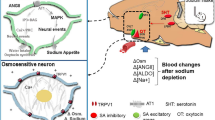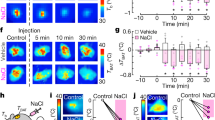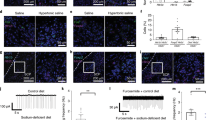Abstract
OBJECTIVE: Neurons in the area postrema/nucleus of the solitary tract (AP/NTS) region mediate amylin's anorectic effect elicited by a single intraperitoneal (i.p.) injection of a low dose (5 μg/kg). Here, we tested if a sustained elevation in amylin levels which was achieved by chronic amylin infusion reduces food intake by acting in the AP/NTS region or, possibly, at other brain sites. Further, we tested the role of the AP/NTS region in mediating the anorectic effects of high doses of amylin and its receptor agonist salmon calcitonin (sCT) after an acute single injection.
DESIGN: Amylin (2 μg/kg/h) was chronically infused i.p. by osmotic minipumps in AP/NTS-lesioned (AP-X) or sham-lesioned (SHAM) rats. For the acute experiments, amylin or sCT was injected i.p. at doses of 0.5 (only sCT), 5 or 50 μg/kg. Food intake was measured by a computerized system. Body weight was assessed by manually weighing the rats.
RESULTS: Amylin significantly reduced cumulative food intake for about 7 days in SHAM but not in AP-X rats. Amylin's effect in SHAM rats was mainly due to a reduction of the size of nocturnal meals (eg average meal size during the first four dark phases; SHAM, NaCl 4.1±0.6 vs amylin 2.6±0.4 g; n=6, P<0.05; AP-X, 2.6±0.3 vs 3.7±0.3) while light phase food intake was unaffected. Body weight gain over the whole 14 day infusion period was reduced by amylin in SHAM (NaCl 61±6 vs amylin 46±4 g; P<0.05) but not in AP-X rats (54±4 vs 62±4). After single injection, the anorectic effect of high doses of amylin and sCT (50 μg/kg) was attenuated, but not abolished, in AP-X rats.
CONCLUSION: We conclude that, under our experimental conditions, neurons in the AP/NTS region are necessary for chronically elevated peripheral amylin to reduce food intake in rats. High doses of amylin, however, may be able to overrun these receptors and reduce feeding by acting at other brain sites.
This is a preview of subscription content, access via your institution
Access options
Subscribe to this journal
Receive 12 print issues and online access
$259.00 per year
only $21.58 per issue
Buy this article
- Purchase on Springer Link
- Instant access to full article PDF
Prices may be subject to local taxes which are calculated during checkout



Similar content being viewed by others
References
Lutz TA, Geary N, Szabady MM, Del Prete E, Scharrer E . Amylin decreases meal size in rats Physiol Behav 1995 58: 1197–1202.
Chance WT, Balasubramaniam A, Zhang FS, Wimalawansa SJ, Fischer JE . Anorexia following the intrahypothalamic administration of amylin Brain Res 1991 539: 352–354.
Lutz TA, Senn M, Althaus J, Del Prete E, Ehrensperger F, Scharrer E . Lesion of the area postrema/nucleus of the solitary tract (AP/NTS) attenuates the anorectic effects of amylin and calcitonin gene-related peptide (CGRP) in rats Peptides 1998 19: 309–317.
Lutz TA, Althaus J, Rossi R, Scharrer E . Anorectic effect of amylin is not transmitted by capsaicin-sensitive nerve fibres Am J Physiol 1998 274: R1777–R1782.
Rushing PA, Hagan MM, Seeley RJ, Lutz TA, Woods SC . Amylin: a novel action in the brain to reduce body weight Endocrinology 2000 141: 850–853.
Arnelo U, Permert J, Adrian TE, Larsson J, Westermark P, Reidelberger RD . Chronic infusion of islet amyloid polypeptide causes anorexia in rats Am J Physiol 1996 271: R1654–R1659.
Arnelo U, Reidelberger R, Adrian TE, Larsson J, Permert J . Sufficiency of postprandial plasma levels of islet amyloid polypeptide for suppression of feeding in rats Am J Physiol 1998 275: R1537–R1542.
Woods SC, Seeley RJ, Porte D Jr, Schwartz MW . Signals that regulate food intake and energy homeostasis Science 1998 280: 1378–1383.
Rushing PA, Lutz TA, Seeley RJ, Woods SC . Amylin and insulin interact to reduce food intake in rats Horm Metab Res 2000 32: 62–65.
Gebre-Medhin S, Mulder H, Pekny M, Westermark G, Törnell J, Westermark P, Sundler F, Ahren B, Betsholtz C . Increased insulin secretion and glucose tolerance in mice lacking islet amyloid polypeptide (amylin) Biochem Biophys Res Commun 1998 250: 271–277.
Lutz TA, Rossi R, Althaus J, Del Prete E, Scharrer E . Amylin reduces food intake more potently than calcitonin gene-related peptide (CGRP) when injected in to the lateral brain ventricle in rats Peptides 1998 19: 1533–1540.
Edwards GL, Power JD, Young AA . Attenuation of the satiogenic effects of amylin by lesions of the area postrema, but not by intraperitoneal capsaicin. (Abstract) Soc Neurosci Abstr 1998 24: 406.3.
Beaumont K, Kenney MA, Young AA, Rink TJ . High affinity amylin binding sites in rat brain Mol Pharmac 1993 44: 493–497.
Young AA, Vine W, Gedulin BR, Pittner R, Janes S, Gaeta LSL, Percy A, Moore CX, Koda JE, Rink TJ, Beaumont K . Preclinical pharmacology of pramlintide in the rat: comparisons with human and rat amylin Drug Dev Res 1996 37: 231–248.
Lutz TA, Tschudy S, Rushing PA, Scharrer E . Amylin receptors mediate the anorectic action of salmon calcitonin (sCT) Peptides 2000 21: 233–238.
McGlone JJ, Ritter S, Kelley KW . The antiaggressive effect of lithium is abolished by area postrema lesion Physiol Behav 1980 24: 1095–1100.
Riediger T, Rauch M, Jurat G, Schmid HA . Cellular mechanisms of amylin activating area postrema and subfornical organ neurons. (Abstract) Soc Neurosci Abstr 1999 25: 856.2.
Rowland NE, Crews EC, Gentry RM . Comparison of Fos induced in rat brain by GLP-1 and amylin Regul Pept 1997 71: 171–174.
Rowland NE, Richmond RM . Area postrema and the anorectic actions of dexfenfluramine and amylin Brain Res 1999 820: 86–91.
Miller CC, Dilts RP, Young AA, Edwards GL . Lesion of the area postrema (AP) attenuates hindbrain cFos expression after amylin treatment. (Abstract) Soc Neurosci Abstr 1998 24: 847.10.
Permert J, Larsson J, Fruin, AB, Tatemoto K, Herrington MK, von Schenck H, Adrian TE . Islet hormone secretion in pancreatic cancer patients with diabetes Pancreas 1997 15: 60–68.
Ohsawa H, Kanatsuka A, Yamaguchi T, Makino H, Yoshida S . Islet amyloid polypeptide inhibits glucose-stimulated insulin secretion from isolated rat pancreatic islets Biochem Biophys Res Commun 1989 160: 961–967.
Young AA, Carlo P, Rink TJ, Wang MW . 8-37hCGRP, an amylin receptor antagonist, enhances the insulin response and perturbs the glucose response to infused arginine in anesthetized rats Mol Cell Endocrinol 1992 84: R1–R5.
Geary N, Asarian L, Langhans W . The satiating potency of hepatic portal glucagon in rats is not affected by insulin or insulin antibodies Physiol Behav 1997 61: 199–208.
Acknowledgements
The excellent help of Silke Haag and Alois Estermann in performing the surgical procedures and the financial support by the Swiss National Research Foundation (grant no. 3100-058799.99/1) are gratefully acknowledged.
Author information
Authors and Affiliations
Corresponding author
Rights and permissions
About this article
Cite this article
Lutz, T., Mollet, A., Rushing, P. et al. The anorectic effect of a chronic peripheral infusion of amylin is abolished in area postrema/nucleus of the solitary tract (AP/NTS) lesioned rats. Int J Obes 25, 1005–1011 (2001). https://doi.org/10.1038/sj.ijo.0801664
Received:
Revised:
Accepted:
Published:
Issue Date:
DOI: https://doi.org/10.1038/sj.ijo.0801664
Keywords
This article is cited by
-
Hindbrain circuits in the control of eating behaviour and energy balance
Nature Metabolism (2022)
-
Regulation of diurnal energy balance by mitokines
Cellular and Molecular Life Sciences (2021)
-
An amylin analogue attenuates alcohol-related behaviours in various animal models of alcohol use disorder
Neuropsychopharmacology (2019)
-
The metabolic effects of GDF15 are mediated by the orphan receptor GFRAL
Nature Medicine (2017)
-
Gut hormones such as amylin and GLP-1 in the control of eating and energy expenditure
International Journal of Obesity Supplements (2016)



